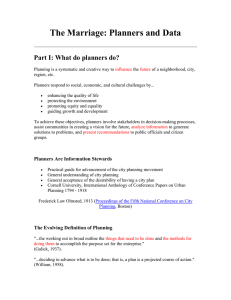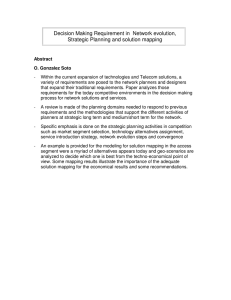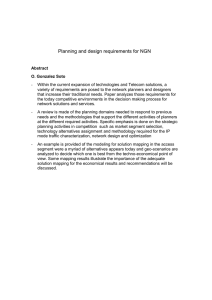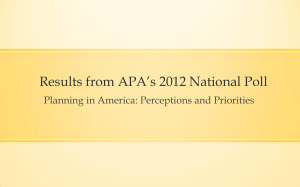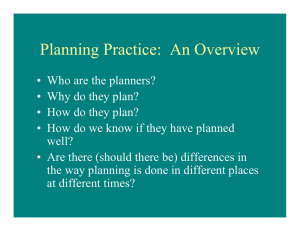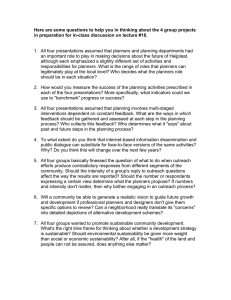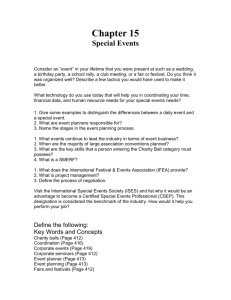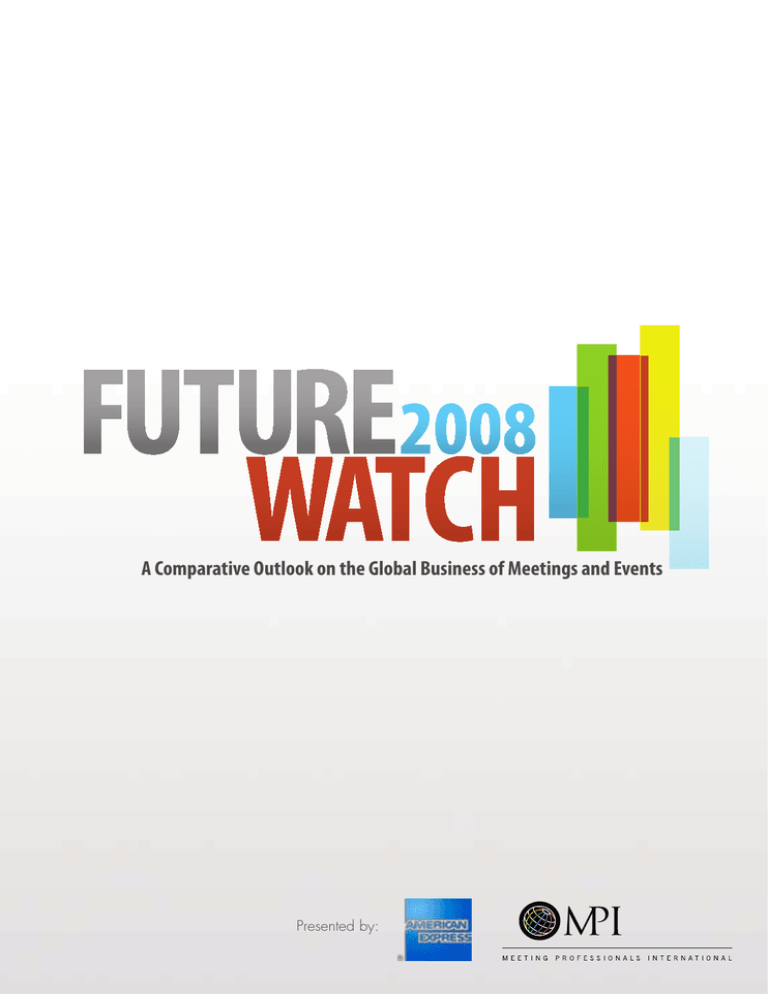
A Comparative Outlook on the Global Business of Meetings and Events
Presented by:
FutureWatch 2008: A Comparative Outlook on the Global Business of Meetings
1
[ Amex Ad]
Content Guide
Overview
QuickStats ..................................................03
The Year Ahead ...........................................04
Meeting Budgets ........................................09
Meeting Technology ...................................10
The Global Face of Meetings .......................13
The Business of Meetings ...........................14
A Business of Relationships ........................16
About FutureWatch 2008 .........................20
For the sixth consecutive year, the annual FutureWatch survey conducted by Meeting
Professionals International (MPI), in partnership with American Express, takes the pulse of the
meetings and events industry and reports on industry trends expected for the coming year.
As in years past, the trends presented in FutureWatch 2008 reflect the economic and societal
trends impacting the world.
FutureWatch 2008
Participants
In this year’s study, we asked planners to report on the trends internal to their
organization, such as:
• Workload
• Budgets
• Shifting organizational goals and strategies
• Centralization of the planning function
• Use of virtual, or webcast, meetings and the current and future
involvement of planning departments in those activities
611 Client-side planners:
corporate, association, government,
non-profit and others planning meetings and
events for clients internal to their organization
Based on survey responses from 1,643 meeting professionals, FutureWatch 2008 provides a
portrait of an industry that is strong, thriving and moving quickly to meet a variety of internal
and external challenges.
265 Meeting management and service
Planners, suppliers and meeting management and service professionals were
asked to report on the more global trends expected to impact the industry:
• Various factors impacting the cost of doing business, such as the
cost of oil and gas and general inflation
• Possible economic downturn or recession
• Increasing globalization of both client- and supplier-side organizations
732 Meeting and event suppliers:
Finally, we asked respondents to identify trends in how planners, suppliers and
meeting management organizations might work together in tomorrow’s
marketplace. Topics include:
• The technologies planners will seek in 2008 and the availability of solutions
• Tomorrow’s outsourcing – what will be outsourced and to whom?
• Where suppliers’ clients reside, whether within our outside the organization
• The successes and challenges of preferred vendor programs and the
involvement of procurement departments in the purchasing process
• The steps suppliers are taking to build loyalty among their planner clients
and what planners would prefer
• Location of meetings across the regions of the world and types of venues
professionals or intermediaries:
independent planners, PCOs (professional
conference organizers) and those working for
third-party, multi-management, site selection
or other meeting services providers
meeting facilities such as hotels and resorts,
convention and conference centers and unique
venues, convention and tourism bureaus,
transportation providers and other onsite
service providers such as caterers and
production companies
*Please note:
In every instance where the title “meeting
professional” is referred to, it is meant to be
inclusive of the “event professional” as well.
FutureWatch 2008: A Comparative Outlook on the Global Business of Meetings
1
[ section image ]
QuickStats
• Meeting planners and suppliers generally predict a steady market
for meetings and events over the next year, with little or no change in
overall volume.
• Planners foresee healthy increases in average meeting attendance
from 2007 to 2008—by 11% for corporate meetings, 18.3% for
association events and 19% across all conferences.
• Budgets and workloads are important in-house issues facing
meeting professionals. A large proportion of respondents also expect
to be involved with shifting goals and strategies within their
organizations. Economic issues, fuel costs and changing technologies
lead the list of external issues and trends.
• A growing number of meeting professionals—19% overall, 31%
in Europe and 29% in Canada—list conservation and environmental
concerns among the top three external trends affecting their work.
Six percent overall, 12% in Europe and 10% in Canada list these
concerns as their leading external trend.
• Labor shortages are roughly twice as important for suppliers
and independent planners as they are for corporate and association
planners, suggesting that concern over the ability to hire and retain
qualified employees is gradually permeating the industry.
• Meeting planners predict an 11% increase in their budgets over
the next year, although expectations vary across sectors—while
corporate planners anticipate a 27% increase and association
planners expect their budgets to shrink by 9.3%. Spending on
individual meetings will grow by 22.6% between 2007 and 2008, the
equivalent of a doubling every 3.1 years.
• Less than one-fifth of meetings business is predicted to be
outsourced in 2008, but the total will still represent a 13% increase
in volume and a 13% increase in spend over 2007. Buyers are three
times as likely to outsource logistics and meeting services, as opposed
to broader meetings strategy development.
• FutureWatch 2008 reveals a small reversal of the trend toward
centralization of responsibility for meetings functions, with fewer
corporate planners working in completely centralized environments
compared to last year. Consolidation of meetings and events budgets
across entire organizations is still on the rise.
• The large majority of FutureWatch 2008 respondents report
some role for procurement and purchasing departments in meetings
and events, and that role is expected to increase over the next year.
However, only about one in four respondents report significant cost
savings or service improvements as a result. Almost half said
procurement has “created significant frustration or difficulty” with
contracting processes, timing or decision-making.
• In their dealings with meeting facilities, planners are more likely
to choose city hotels than any other type of venue. Resort hotels are
primarily of interest to corporate and independent planners,
particularly in the United States. Conference centers and university
settings are most likely to draw government-hosted events and
are most popular in Europe, while convention centers will draw the
largest share of their business from association and independent
planners.
• Meeting professionals expect hotel rates to increase by an average
of 8% over the next year.
• Although meeting professionals will make use of a wide variety
of onsite technologies in 2008, they are not always satisfied with the
adequacy, availability, accessibility or affordability of those
technologies.
• Two in five meeting planners, and nearly half of corporate
planners, expect their use of webcasts to increase in the next year.
Three in 10 planners expect webcasts to be a more frequent feature of
live meetings, leading to an overall increase in attendance at
meetings that combine live and virtual audiences.
• The meetings and events industry is globalizing rapidly. Although
the majority of FutureWatch 2008 respondents work for
organizations with operations in only one country, 20% expect their
global reach to expand over the next year. And companies with the
widest spheres of operation are most likely to expand— 57% of
respondents in organizations with offices in six or more countries
expect expansion in 2008.
FutureWatch 2008: A Comparative Outlook on the Global Business of Meetings
3
THE YEAR AHEAD
A STEADY MARKET
For the most part, FutureWatch respondents predict a steady
meetings market over the next year, with most categories foreseeing
little or no change in the number of meetings they will organize or
supply. Although independent planners are the only group looking
ahead to significant growth, there is little concern about the
slowdown that has been predicted in some industry publications.
• Corporations were far more likely than associations or government
agencies to organize 100 or more meetings in 2007, and planners
predict the same trend for 2008. Overall, the number of planners who
expect their organizations to arrange 100 or more events declined
from 148 in 2007 to 125 in 2008. (See chart on page 5)
• The overwhelming majority of organizations involved with 100 or
more meetings are based in the United States. • The majority of respondents in all categories (55.7% for 2007,
52% for 2008) expect to be personally involved with 30 or fewer
meetings, although almost one-quarter (22.7% for 2007, 23.7% for
2008) say they will have a hand in 50 to 200 events.
• Meeting planners foresee healthy increases in average meeting
attendance from 2007 to 2008—by 11.2% for corporate meetings,
18.3% for association events and 19.3% across all conferences, after
accounting for a relatively small sample of government planners.
Somewhat higher numbers of meeting planners expect their events
to draw 500 or more attendees, though roughly two-thirds (68.4%
for 2007, 65.1% for 2008) expect average attendance in the 50 to 500
range. Corporate planners predict average turnouts of 278 in 2007
and 308 in 2008, while association planners anticipate 600 in 2007
and 710 in 2008. (See chart on page 5)
Expected Number of Meetings by Respondent Category
2007
2008
196
194
All Planners
262
Corporate
273
80
Association
76
431
Independent Planners
651
436
Suppliers
458
0
100
200
300
400
500
600
700
800
PREDICTED AVERAGE ATTENDEES PER MEETING
Attendance
Category
All Planners
2007
Corporate
Association
2008
2007
2008
2007
2008
1-49
14.1%
13%
15.8%
14.9%
11.8%
10.8%
50-99
25.2%
20.9%
29.8%
23.8%
18.9%
16.8%
100-199
23%
22.4%
21.3%
21.5%
24.5%
23.2%
200-499
20.3%
21.9%
19.5%
21.5%
21.4%
22.2%
500+
17.4%
21.9%
13.6%
18.2%
23.5%
27%
Avg. Attendance
405
482
278
309
600
710
PREDICTED AVERAGE LENGTH OF MEETING
Length
in Days
All Planners
Corporate
Association
2007
2008
2007
2008
2007
2008
1
22%
21.7%
16.1%
17.5%
26.8%
25.1%
2
25.8%
25.6%
25.3%
24.5%
27.2%
26%
3
32.8%
33.6%
37.8%
39.3%
27.2%
27.9%
4
12.4%
11.7%
13.8%
12.5%
11.4%
11.9%
5
5.8%
5.8%
6.3%
5.1%
5.7%
7.3%
6+
1.3%
1.6%
0.7%
1.2%
1.8%
1.8%
Avg. Length
2.6
2.6
2.7
2.7
2.5
2.6
• The majority of planners
(58.6% for 2007, 59.2% for 2008)
expect their meetings to run an
average of two to three days, and
the large majority (80.6% for 2007,
80.9% for 2008) place their events in
the one- to three-day range.
• Corporations tend slightly
toward longer meetings of three to
five days compared to
associations.
FutureWatch 2008: A Comparative Outlook on the Global Business of Meetings
5
In-house trends: Budgets, workloads and
the emergence of strategy
For the fifth year, FutureWatch asked
respondents to list the three most
important internal trends they will face
in the year ahead. While budget and
workloads continue to dominate as
hot-button concerns in most member
categories, the data points to an
emerging focus on the strategic purpose
of meetings and a more senior role for
the people who produce and supply
them.
TOP INTERNAL TRENDS, 2008
• Budget changes are the leading
trend in 2008, placing as a top concern
for three out of 10 independent
planners, four out of 10 in all other
planner and supplier categories, and
four out of 10 overall.
All Respondents
{
{
{
1. Budget changes
2. Shifting goals and strategies
within organization
3. Workloads
Corporate
1. Budget changes
2. Workloads
3. Changes in the way meetings
are viewed or used in-house
Association
Independent
{
1. Budget changes
2. Workloads
3. Changes in use of outsourcing
Suppliers
{
1. Budget changes
2. Shifting goals and strategies
within organization
3. Changes in attendees’
preferences and expectations
1. Budget changes
2. Shifting goals and strategies
within organization
3. Workloads
• Shifting organizational goals and strategies are a priority for 40%
of association planners and nearly 30% of respondents in all member
categories.
• Workloads are the second-ranked trend for corporate and
independent planners and placed third overall.
• Nearly one-third of corporate planners expect changes in the way
their organizations view or use meetings, while one-quarter of suppliers anticipate changes in attendee preferences and expectations.
• Familiar issues like lead times, outsourcing, meetings
centralization and the role of procurement received relatively low
priority, with one exception: Independent planners are considerably
more likely to predict changes in the use of outsourcing and the role
of procurement over the next year.
Respondents’ write-in responses point to meetings technology,
globalization, exchange rates, changes and expansion in the supply
of meeting facilities and what one member calls the “explosion of the
sustainability and energy efficiency market” as important emerging
issues.
“Our organization is always moving and changing, so flexibility in the
fulfillment of the job is required,” commented one respondent. With
increased use of the Internet, “the pitch is getting bigger and bigger,
so the offer needs to be more original and more special. Uniqueness
and experience will be main specifications for meetings and events.”
External trends: Fretting about the
economy
For suppliers, in particular, economic worries outweigh all other
concerns in FutureWatch respondents’ assessment of the external
issues and trends their organizations will face in 2008.
And what a difference a year can make! In 2007, meeting professionals cited the impact on business travel of terrorism and war as the
most serious external trend facing the industry. In 2008, the issue
placed 10th, with only 13.6% of FutureWatch respondents
identifying it as a top concern.
• Inflation and the prospect of an economic downturn or recession
are on the radar for all respondents, but particularly for suppliers
and association planners. More than two-fifths of suppliers say an
economic downturn will affect their business in 2008, and almost
the same proportion of association planners expressed concern about
inflation and rising costs. Among suppliers, and across all respondent
groups, the proportion predicting a recession outnumbered those
who expected a stronger economy by a 2.5:1 margin.
• Worries about an economic downturn are slightly more
pronounced among sales professionals, and significantly more so for
respondents from the United States: Recession fears emerged as a
top concern for 40% of meeting professionals in the U.S., compared
to 24.1% in Europe and 22.8% in Canada. Similarly, inflation is an
immediate concern for 36.2% of U.S. respondents, but only 20% of
Canadians and Europeans.
• Suppliers’ concerns about oil and gas
costs and their impact on travel are
sufficient to propel the issue to second
spot in respondents’ list of external
trends. The issue is particularly
prevalent in the United States, where
36.3% give it a high ranking.
• Changes in technology are the
top-ranked trend for corporate and
independent planners, and placed
fourth overall. One-quarter of
FutureWatch respondents and
one-third of association planners point
to increased access to and availability of
online information.
• Conservation and environmental
concerns emerged as a trend to watch.
Nineteen percent of respondents—
including 30.7% in Europe and 29%
in Canada—place the topic in their
top three. Six percent overall, 12.1% in
Europe and 10.3% in Canada list it as
their leading external trend.
TOP EXTERNAL TRENDS, 2008
All Respondents
{
{
{
1. Economic downturn and recession
2. Cost of oil and gas
3. Inflation/rising costs
4. Changes or advances in technology
5. Increased access to information online
6. Environmental concerns
Corporate
1. Changes or advances in technology
2. Inflation/rising costs
3. Economic downturn or recession
4. Cost of oil and gas
5. Government regulation
6. Increased access to information online
Association
Independent
{
{
1. Changes or advances in technology
2. Economic downturn and recession
3. Globalization of markets
4. Inflation/rising costs
5. Increased access to information online
6. Cost of oil and gas
Suppliers
1. Economic downturn or recession
2. Cost of oil and gas
3. Inflation/rising costs
4. Increased access to information online
5. Changes or advances in technology
6. Environmental concerns
1. Inflation/rising costs
2. Changes or advances in technology
3. Increased access to information online
4. Economic downturn or recession
5. Cost of oil and gas
6. Aging population
DIFFERENT VIEWS
Although meeting professionals are fairly consistent in their
identification of leading trends, FutureWatch revealed a number of
differences in perspective and experience across industry groupings.
• Changing technology is of considerably greater interest to
planners in all categories than to suppliers.
• Labor shortages are roughly twice as important for suppliers
and independent planners as they are for corporate and association
planners, suggesting that concern over the ability to hire and retain
qualified employees is gradually permeating the industry.
• In a separate question, Canadian planners and suppliers were
asked to describe the impact of a labor shortage that is somewhat
more advanced in their country than it might be elsewhere. Staffing
issues in hotels, restaurants and convention centers emerged as the
overwhelming concern, with 77.3% of Canadian respondents—
though, curiously, only 72.1% of suppliers—assigning the issue a
high ranking. Solid majorities of Canadian respondents say the labor
shortage will result in fewer meetings with lower attendance; 37.9%
of all Canadians and 52.4% of suppliers predict that some meetings
will move to the United States. About one in five corporate planners
say the labor shortage will lead companies to hold more meetings in
Canada.
• Government regulation is a more serious concern for corporate
planners than for any other respondent category. Just over one in five
corporate planners identify regulation as a top trend, but the
proportion increases to 41.8% among pharmaceutical planners,
30.4% among insurance industry planners and about 25% in the
financial and non-pharma healthcare industries.
• Independent planners are more than twice as likely as their
association counterparts to see a globalized industry as a top trend
for 2008. Globalization is a leading issue for 32.7% of European
respondents, 21.4% of Canadians and 15.6% of Americans. About
6% of respondents, but almost 20% of Europeans, see economic
opportunities in China and other developing countries as an emerging
trend for 2008. Passport and visa regulations are primarily a concern
for meeting professionals in Canada—and even there, only 18.6%
identified passport access as a leading issue for the next year.
• Association planners are considerably more likely than other
respondent categories to see an aging population as a priority
concern.
FutureWatch 2008: A Comparative Outlook on the Global Business of Meetings
7
A knowledge-based industry
Out of 1,643 meeting professionals who
took part in FutureWatch 2008,
99 (6%) teach meeting- or eventrelated courses at the college level.
The group includes 41 suppliers, 32
independent planners and 20 corporate,
association and government planners.
MEETING BUDGETS
The educators were asked to rank the
importance of seven different strategies
to advance the meetings profession.
Better understanding of the profession within procurement and finance
received a 4.41 rating on a 1 to 5 scale,
where 5 is most important, followed by
better understanding within marketing
and communications and a better
ability to assess and report a meeting’s impact.
HOW TO ADVANCE THE MEETING PROFESSION
RANK
4.41 Better understanding of the profession with procurement and finance
4.38 Better understanding of the profession with marketing and communications
4.38 Better ability to asses and report the impact of meetings
4.30 Better communication and collaboration between the industry and
university/college programs
4.28 Better understanding of the profession within human resources
3.99 More research in the field
3.96 More defined career paths
Meeting budgets: An upward trajectory
The 611 corporate association and government meeting planners who responded to FutureWatch
2008 generally anticipate an upward trajectory in their 2008 meeting budgets, and in the money
they invest in each individual event.
MEETING ORGANIZATION BUDGETS 2007-2008 (%)
All Respondents
Corporate
Association
2007
2008
2007
2008
2007
2008
under $200,000
24.6
24.1
14.1
15.4
33.0
30.6
$200,000 - $499,999
17.9
16.5
14.1
10.8
22.0
20.0
$500,000 - $999,999
8.4
11.4
9.0
9.2
7.5
12.9
$1 to $2.5 million
20.1
19.6
19.2
20.0
19.8
18.8
11.8
$2.5 to $5 million
12.8
12.0
15.4
12.3
9.9
$5 million or more
15.1
15.2
28.2
32.3
5.5
3.5
Avg. ($ million)
3.95
4.40
6.03
7.66
2.46
2.23
Change
11.4
27.0
• More than one-quarter of
planners, and nearly half of corporate
planners, will work in organizations
with meetings budgets of $2.5
million or more. Another 20% will
have budgets in the $1 to $2.5
million range.
-9.3
• Although association planners
report lower budgets overall, their
spend on individual meetings will
grow even faster than the industry
average. For the industry as a whole,
the 22.6% increase between 2007
and 2008 will be the equivalent of a
doubling every 3.1 years.
AVERAGE MEETING BUDGETS 2007-2008 (%)
All Respondents
Corporate
Association
2007
2008
2007
2008
2007
2008
Under $10,000
23.1
20.3
22.3
18.8
20.7
17.5
$10,000 - $49,999
38.3
32.7
32.3
28.7
45.9
31.1
$50,000 - $99,999
9.7
15.2
11.5
14.9
8.1
14.6
$100,000 - $199,999
10.9
10.6
13.1
12.9
9.0
8.7
$200,000 - $499,999
8.0
10.1
9.2
12.9
8.1
8.7
$500,000 - $999,999
4.7
6.0
5.4
5.9
4.5
5.8
$1 million or more
4.3
4.6
4.6
5.0
3.6
4.9
Avg. ($ million)
$152,906
$187,537
$175,011
$212,783
$135,356
$174,389
Change
22.6
21.6
28.8
% of meetings that
generate profit
32.2
21.3
49.1
• The largest single share of the
market—just over half in the
association sector and for the industry
as a whole—will be in meetings with
budgets below $50,000. Corporate
planners will organize a slightly larger
share of meetings worth $100,000
or more.
MEETINGS AS A SHARE OF ORGANIZATIONAL BUDGETS, 2008 (%)
Higher than 2007
The same proportion as 2007
Less than 2007
8.6
17.2
25.5
24.2
22.2
30.0
61.3
57.3
All Respondents
53.6
Corporate
Association
• Although association
planners predict a 9.3% decrease in
meeting budgets, their corporate
colleagues are on track for a 27%
increase. As a group, planners predict
a budget increase of 11.4%.
• Half of association meetings
are expected to generate a profit,
compared to only one in five
corporate meetings. This sharp
difference reflects the extent to which
non-profit organizations depend on
direct revenue from meetings and
events, compared to the other types
of return that corporations expect
from their meetings investment.
• While association planners expect
their budgets to remain steady or
increase as a share of their
organizations’ total spending, one in
four corporate planners expect their
budgets to be cut.
FutureWatch 2008: A Comparative Outlook on the Global Business of Meetings
9
MEETING TECHNOLOGY
A TOUGH SELL
Meeting professionals are generally a tough sell when it comes to the
technologies available to facilitate meetings and events.
FutureWatch 2008 invited respondents to rank five top technology
areas from a list of 16 options, then assess all 16 for their adequacy,
availability, accessibility and affordability. The results show that technology developers have some way to go in meeting the expectations
of an increasingly sophisticated market.
Top technologies
Across all respondent categories, the most popular meeting
technology areas are attendee feedback systems, RFP systems,
meetings interaction software, improved Internet access on-site,
audiovisual equipment, meeting logistics tools, customer
relationship management (CRM) software and attendee identification
and tracking systems. But the overall figures mask a range of more
specific needs.
• More than half of suppliers, but only 19.3% to 36.6% in different
planner categories, attach high importance to technologies that
facilitate the RFP process. Two in five suppliers, but only 12% to
23.8% in different planner groups, are interested in CRM systems.
• Government planners express significantly more interest in
audiovisual technologies and meeting logistics tools than their
colleagues in other areas.
• Badge and registration solutions, radio frequency identification
and other attendee identification and tracking systems have landed
solidly on the radar of corporate, association and independent
planners, and have emerged as a priority for one in five planners.
• Systems to share conference content and course documents are of
interest to 40.3% of association planners, but to only 25.3% of
FutureWatch 2008 respondents overall.
• More than one in three corporate and association planners are
looking for alternatives to live meetings, but the trend has only
registered with 15.8% of suppliers. Tools that allow remote participation in live meetings are of interest to nearly one-third of association
and government planners, but only 17.6% of suppliers.
MEETING PROFESSIONALS’ 2008 TECHNOLOGY PICKS (%) (ALL RESPONDENTS)
54.0 Attendee feedback systems
39.7 RFP systems
39.4 Meeting interaction software
39.3 Better onsite Internet access
38.0 Audiovisuals
35.4 Meeting logistic tools
28.9 CRM software
28.8 Attendee ID/tracking systems
28.5 Attendee schedulers
28.1 Vendor/site selection tools
25.6 Vendor/site evaluation tools
25.3 Content and document sharing
24.2 Alternatives to live meetings
23.6 Onsite networking tools
22.0 Remote participation tools
19.0 Match attendees with relevant
content, vendors, exhibitors, peers
MEETING PROFESSIONALS’ TOP TECHNOLOGY PICKS FOR 2008, BY CATEGORY (%)
All
Corporate
Association
Government
Independent
Suppliers
Attendee feedback Systems
54
52.8
54.7
48.0
50.9
55.3
RFP systems
39.7
30.6
19.3
32.0
36.6
52.9
Meetings interaction software
39.4
39.7
39.1
28.0
43.4
38.3
Better onsite Internet access
39.3
36.7
36.6
36.0
33.6
44.5
Audiovisuals
38.0
35.6
38.7
60.0
38.1
38.3
Meeting logistics tools
35.4
37.9
39.1
56.0
37.7
31.3
CRM software
28.9
16.3
14.8
12.0
23.8
42.5
Attendee ID/tracking systems
28.8
37.9
35.8
32.0
35.1
20.1
Assessing the technologies
READY FOR PRIME TIME?
MEETING PROFESSIONALS’ ASSESSMENT OF MEETING TECHNOLOGIES, 2008
Market
Flooded
Adequate,
affordable,
accessible
Adequate
but not
affordable/
accessible
Available
but not
adequate
No tool or
resource
Attendee feedback Systems
6.3%
37.5%
27.1%
22.3%
6.8%
RFP systems
8.4%
31.1%
25.3%
29.2%
6%
Meetings interaction software
4.6%
32.7%
33.5%
23.3%
5.9%
Better onsite internet access
6%
34.4%
30.9%
23.9%
4.8%
Audiovisuals
6.7%
34.7%
32.2%
20.8%
5.6%
Meeting logisitics tools
7.7%
28.1%
30.3%
27.5%
6.4%
CRM software
9.7%
30.9%
29.3%
22.9%
7.2%
Attendee identification/tracking systems
10.1%
30.2%
31.6%
21.9%
6.1%
Most Interested
Least Interested
Attendee schedulers
6.8%
32.1%
32.3%
21.8%
7.1%
Vendor/site selection tools
8%
32.5%
23.6%
28%
7.8%
Vendor/site evaluation tools
4.8%
33.1%
25.7%
26.7%
9.8%
Share content and documentation
7.9%
35.1%
32.2%
19%
5.8%
Alternatives to live meetings
6.8%
32%
35.3%
20.4%
5.5%
Onsite networking tools
5.9%
30.7%
34.9%
23%
5.4%
Remote participation tools
8%
32.4%
31.3%
22.7%
5.5%
Match attendees with relevant content,
vendors, exhibitors, peers
6.7%
31.1%
28.5%
26.9%
6.7%
Even with the technologies they
think they will need and use,
meeting professionals are not yet
satisfied with the options available
to them.
• Respondents’ ratings of all the
technologies fall into a relatively
narrow band, with only 35.8% to
43.8% stating that any technology
is ready for prime time—that the
available options are adequate,
affordable and accessible, or that
they have already flooded the
market.
• Of the eight technology
categories of greatest interest to
planners and suppliers, only five
fall into the top tier for customer
satisfaction. RFP systems rank
second in importance, but ninth
on overall satisfaction and last on
adequacy. Meeting logistics tools
are third-most important, but rank
last on overall satisfaction.
FutureWatch 2008: A Comparative Outlook on the Global Business of Meetings
11
The rise of webcasts
MEETING PLANNERS’ VIEW OF WEBCASTS, 2008 (%)
All
Corporate
Association
Government
Independent
More or much more frequent
40.7
48.1
39.5
36.0
33.2
33.6
Steady
30.2
28.3
29.2
32.0
Less or much less frequent
15.0
12.5
15.6
12.0
19.2
Average (1 - 5 scale)
3.49
3.68
3.41
3.5
3.29
MEETING PLANNERS’ VIEW OF WEBCASTS AS A FEATURE OF LIVE MEETINGS, 2008 (%)
All
Corporate
Association
Government
Independent
More or much more frequent
30.2
36.2
25.9
28.0
27.5
Steady
33.3
29.4
35.4
20.0
37.4
Less or much less frequent
20.1
17.5
21.0
32.0
22.3
Average (1 - 5 scale)
3.18
3.33
3.1
3.05
3.09
WEBCASTS’ IMPACT ON LIVE ATTENDANCE AT MEETINGS, 2008 (%)
All
Corporate
Association
Government
Independent
Increase or greatly increase
8.2
6.4
6.2
12.0
11.7
Steady
49.5
46.6
51.4
44.0
53.2
Decrease or greatly decrease
6.9
7.9
7.0
16.0
5.3
Average (1 - 5 scale)
2.78
2.70
2.75
2.75
2.89
WEBCASTS’ IMPACT ON TOTAL MEETING ATTENDANCE, 2008 (%)
All
Corporate
Association
Government
Independent
Increase or greatly increase
26.9
26.2
21.0
24.0
31.7
Steady
43.1
40.5
49.4
40.0
43.4
Decrease or greatly decrease
4.8
4.7
5.3
8.0
4.9
Average (1 - 5 scale)
3.23
3.21
3.14
3.15
3.29
MEETINGS DEPARTMENTS’ EXPECTED ROLE IN ENCOURAGING WEBCASTS, 2008 (%)
All
Corporate
Association
Government
Independent
Totally or largely involved
39.4
38.8
49.4
52.0
32.1
Average involvement
20.2
19.2
17.3
8.0
25.7
Minimally or not at all involved
27.8
32.7
26.3
28.0
23.4
Average (1 - 5 scale)
3.23
3.12
3.43
3.41
3.18
MEETINGS DEPARTMENTS’ POSITIONING AS GO-TO SOURCE ON WEBCASTS, 2008 (%)
All
Corporate
Association
Government
Independent
Major effort to position
29.0
29.2
34.2
40.0
24.5
Moderate Effort
20.4
19.5
19.3
4.0
24.5
Little or no effort
36.9
42.3
36.2
48.0
30.6
Average (1 - 5 scale)
2.86
2.77
3.02
2.83
2.83
MEETINGS DEPARTMENTS’ EXPECTED INVOLVEMENT IN EXECUTING WEBCASTS, 2008 (%)
All
Corporate
Association
Government
Independent
Totally or largely responsible
26.0
24.2
32.5
20.0
24.2
19.2
Average involvement
15.8
14.3
12.8
24.0
Minimally or not at all responsible
39.3
49.9
37.0
28.0
31.7
Average (1 - 5 scale)
2.71
2.48
2.92
2.94
2.82
Members predict rising use of
webcasts, though not necessarily
as decisively as the industry buzz
would suggest. Two in five meeting
planners, and nearly half of corporate
planners, expect their use of webcasts
to become more or much more frequent in the next year. But across the
entire FutureWatch 2008 sample, a
slightly larger proportion says
webcasting will hold steady or
decline. While the popularity of
webcasts received an average rating
of almost 3.5 on a 1 to 5 scale, the
results still suggest an important
place for face-to-face meetings.
Three in 10 planners expect webcasts
to be a more or much more frequent
feature of live meetings, with
corporate planners leading the way
at 36.2%.
Planners see little likelihood that
webcasts will affect attendance at live
meetings over the next year.
However, they are more likely to
predict an increase in total attendance, live and virtual.
Many meeting planners expect to
lead the shift to webcasts, particularly
in the association and government
markets. When webcasts do take
place, association planners expect
to be more involved in planning and
implementation than planners as a
whole; corporate planners expect to
be somewhat less involved.
A GLOBAL INDUSTRY
The global face of meetings
Although the majority of FutureWatch 2008 respondents work for
organizations that operate in only one country, their predictions for
the next year reflect an industry that is globalizing rapidly. One in
five expects their organizations to extend their global reach in 2008,
compared to only one in 200 who foresee a decrease.
Moreover, companies with the widest spheres of operation are most
likely to expand: 57.3% of respondents in organizations with offices in
six or more countries expected expanded operations in the next year,
compared to 4.5% of their colleagues whose organizations had not
yet entered the international market.
changes IN MEETING PROFESSIONALS’ COUNTRIES OF OPERATION
2007
Decrease
Increase
No Change
One country
59.6
0.0
4.5
86.4
Two countries
56.7
1.1
18.3
65.6
Three to five countries
9.0
1.4
29.1
44.6
Six or more countries
23.7
1.3
57.3
21.6
Total
--
0.5
20.1
64.8
And at a time when MPI is extending its own presence to new regions
of the world, 14.4% of respondents, including 15.9% in Canada and
31.0% in Europe, said they had seen increased interest in holding
meetings in the Middle East.
The Western Hemisphere Travel Initiative:
A measured impact
FutureWatch 2008 invited respondents from the United States and
Canada to comment on the impact of the Western Hemisphere Travel
Initiative. WHTI is a U.S. Congressional initiative that establishes
new passport requirements for travel between the U.S. and Canada,
Mexico and the Caribbean. The results indicate that the WHTI has had
only moderate impact so far, but could become more significant in
the next year.
• One-quarter of Canadian but only 7.4% of U.S. meeting
professionals believe WHTI has already led to a major or slight
decrease in travel by U.S. citizens to meetings outside the United
States. However, 58% of Canadians and 33.6% of Americans expect to
see major or slight decreases in 2008.
• Nearly three-quarters of Canadian and more than one-third of
U.S. meeting professionals believe attendees have been confused by
changing WHTI rules and timelines.
• Nearly half of Canadian and more than one-quarter of U.S.
respondents either report or expect that extra work will be required
to keep up with the provisions of the WHTI, and that workload might
begin with some basic research. Three-fifths of the North American
respondents could not say what proportion of U.S. citizens attending
their meetings outside the United States held valid passports.
FutureWatch 2008: A Comparative Outlook on the Global Business of Meetings
13
THE BUSINESS OF MEETINGS
Outsourcing will increase moderately, but centralization of meeting functions may be somewhat less
prevalent in FutureWatch 2008 respondents’ organizations over the next year.
A gradual rise in outsourcing
Less than one-fifth of meetings business will be outsourced in 2008, but the total will still represent a
13.5% increase in volume and a 13.9% increase in spend over 2007.
For 2007, corporate planners reported that 16.5% of their activity would be fully or partially outsourced,
compared to 7.75% for association planners, 17.1% for government planners and 13.1% for independents.
But that relatively modest base will provide a springboard for respectable outsourcing growth in
2008—by 15.9% for association planners, 14.6% for corporate planners and 6.6% for independents.
Government planners predicted that their outsourced activity would decline by 3.7%.
CHANGES IN MEETINGS BUSINESS FULLY OR PARTIALLY OUTSOURCED 2007-2008 (%)
All
Corporate
Association
Government
Independent
US
Canada
Europe
2007
12.8
16.5
7.8
17.1
13.1
11.7
13.7
20.6
2008
14.6
19.0
9.0
16.5
14.0
12.7
19.2
26.1
Change
13.5
14.6
15.9
-3.7
6.6
8.4
40.3
26.9
CHANGES IN MEETINGS SPEND FULLY OR PARTIALLY OUTSOURCED 2007-2008 (%)
All
Corporate
Association
Government
Independent
US
Canada
Europe
2007
12.9
14.5
7.7
13.0
18.0
12,2
15.4
17.4
2008
14.7
16.9
9.5
14.0
18.3
13.3
17.4
25.2
Change
13.9
16.4
27.1
7.2
1.6
9.1
12.7
44.7
• The largest increases in
outsourcing will occur in Canada
and Europe, where relatively small
respondent groups predicted growth
of 40.3% and 26.9%, respectively.
Respondents from the United States
anticipated an 8.4% increase.
• The table shows the
corresponding increases for meetings
spend, with Europe looking ahead to
a 44.7% increase for 2008.
Buying patterns show that client-side planners are three times as
likely to outsource logistics and meeting services, as opposed to
broader meetings strategy development. Independent planners and
Europeans are most likely to turn to outside consultants for strategic
advice; corporate and government planners most commonly focus
their outsourcing on logistics.
event expenditures were being calculated and reported across the
entire organization, an increase of about 12.6% over 2007.
The pros and cons of procurement
Three-quarters of FutureWatch 2008 respondents, and almost 85%
of respondents in Europe, reported that procurement plays some role
in their purchasing decisions. On a 1 to 5 scale, procurement’s level
of involvement received a score of 3.26 in Europe, 2.48 in Canada and
2.68 across all survey participants.
FutureWatch 2008 respondents were also asked to identify their
most frequent sources of outsourced meeting services. Consistent
with past years’ results, full-service meeting management firms
were the most frequent choice for 2007 and 2008, particularly for
corporate and government planners. Site selection companies were
the most frequent choice for association planners and for client-side
planners in the United States, while independent planners showed a
strong tendency to hire other independents when they outsourced.
Full-service vendors were considerably more popular in Europe than
in North America.
Meeting professionals’ satisfaction with the procurement process
was a different story. Out of a small group of 150 respondents who
described their experience with procurement:
• Only 24%—none of the 14 government planners in the smaller
sample—said procurement processes had led to significant cost
savings.
The pendulum swings on centralization
• Only 26.7%—only one out of 14 government planners—
believed procurement processes had sometimes led to better rooms,
venues, or other services; 15.3% said procurement had led to
reductions in service quality.
A small but visible number of organizations appear to be stepping
back from the tendency to centralize responsibility for meetings
functions with a single individual, team or department.
• 42%, including 10 of the 14 government planners, said
procurement had “created significant frustration or difficulty” with
contracting processes, timing, or decision-making.
In 2007, 54.4% of corporate planners reported that meeting functions
were mostly or completely centralized within their organizations,
compared to 20.7% where meetings were mostly or completely
decentralized. In their responses to FutureWatch 2008, 50.5% of
corporate planners were in centralized environments, compared to
29.6% who were not.
Yet 45% of respondents, including 58.8% in Canada and 66.7% in
Europe, expect procurement to become more involved with meetings
over the next year, compared to only 7.3% who foresee a smaller role.
25.9% expect procurement to become more knowledgeable about
meetings and more helpful to planners, and 22.9% hope procurement
agents will become better, more collaborative partners. A couple of
respondents said their procurement officers routinely follow their
advice on vendor selection; one meetings department had taken over
signing authority on procurement’s behalf. But 21% of respondents
expect the procurement process to become a bigger obstacle to
meeting management.
The trend was more pronounced across larger geographic distances.
In 2007, 48.6% of corporate planners reported that meeting functions
were mostly or completely centralized by geography, compared to
32% whose organizations were mostly or fully decentralized. For
2008, the proportions were 37.9% and 44.3%. Europe and Canada
both showed stronger tendencies toward geographic centralization
compared to the United States.
CENTRALIZATION OF MEETINGS AND EVENTS: CORPORATE PLANNERS
BY FUNCTION
Mostly or completely
decentralized
Mostly or completely
decentralized
Mostly or completely
centralized
Mostly or completely
centralized
20.7
PERCENTAGE OF VENDORS ON PREFERRED
VENDOR AGREEMENTS, 2007
2007
2008
20.7
BY FUNCTION
29.6
29.6
54.4
50.5
BY GEOGRAPHY
32.0
Mostly or completely BY GEOGRAPHY
decentralized
Mostly or completely
decentralized
Mostly or completely
centralized
Mostly or completely
centralized 0
10
20
30
37.9
40
50
60
0
20
30
40
50
60
10
44.3
32.0
44.3
37.9
48.6
48.6
However, even where meeting functions are somewhat less
centralized, consolidated spending is increasingly the norm. Nearly
two-thirds of corporate and government planners said meeting and
All Corporate
US
Canada
Europe
None
1.2
1.4
0.0
0.0
54.4
50.5
1-24%
4.4
4.5
3.4
3.8
25-49%
5.5
5.6
0.0
11.5
50-74%
11.7
10.8
10.3
23.1
75-99%
17.2
16.3
24.1
19.2
No PV list
5.8
6.9
0.0
0.0
Don’t know
20.7
20.8
34.5
3.8
FutureWatch 2008: A Comparative Outlook on the Global Business of Meetings
15
The procurement process has already had an impact on the way
meetings departments buy outsourced services. Just over one in five
independent planners say procurement has had a significant
influence on their fee structures; overall, on a 1 to 5 scale,
independents give the role of procurement a rating of 2.49. Overall,
independents identify project fees as their preferred method of
billing, followed by hourly or daily rates and commissions.
A BUSINESS OF RELATIONSHIPS
Despite the growing links between meetings and procurement
departments, preferred vendor agreements are by no means standard
across the industry. In all jurisdictions except Europe, the majority of
corporate planners say their organizations have no preferred vendor
program, or have never heard the term. Of the planners who use
them, 51% say they are very or extremely satisfied with preferred
vendor agreements, and the approach receives an overall rating of
3.56 on a 1 to 5 scale.
Even more consistently than in past editions of FutureWatch,
suppliers and independent planners report that their direct client
contacts are most often the meeting and event department. For
suppliers, the next-most important contact is an independent planner
or a professional conference organizer; for independents, it is the
department that owns a meeting. Suppliers report to procurement 8%
of the time and independents 5.4% of the time.
VENDORS’ MAIN IN-HOUSE MEETING CONTACTS (%)
Suppliers
Third Parties
2007
2008
2007
2008
Meetings/events department
39
41
31
33
Outside planners/independent/PCO
24
20
17
17
Department that owns the meeting
16
16
30
29
Procurement
8
8
7
5
Advertising, PR or other non-meeting
7
6
7
7
Other
6
8
8
8
Independents’ description of their current and future client base suggests a consolidation and maturing of the
third-party planning market, resulting in a considerably more limited number of very small firms. While
independents expect their average number of clients to grow only 6.2% between 2007 and 2008, their plans for
the next year will translate into a sharp increase in the number of companies with 10 or more clients.
NUMBER OF CLIENTS - INDEPENDENT PLANNERS (%)
2007
2008
24.5
19.9 ( -18.8% Change)
1-4
31.4
5-9
20.5 (-34.7% Change)
18.6
10-19
24.6 (32.3% Change)
9.1
20-29
13.5 (48.4% Change)
16.4
30+
21.6 (31.7% Change)
28.4
Average
30.17 (6.2% Change)
0
5
10
15
20
25
30
35
• Curiously, while many
independents predict an
increase in the number of
meetings they will organize
per client, the overall average
declines by almost 17%. NUMBER OF MEETINGS PER CLIENT - INDEPENDENT PLANNERS (%)
2007
2008
%Change
1
19.0
16.1
-15.3
2
25.5
21.0
-17.7
16.7
3-9
34.8
40.6
10-19
9.8
13.3
35.7
20+
10.9
9.1
-16.5
Average
14.9
12.4
-16.6
Facility choices and rates
City hotels are the most frequent venue choice for all planner categories—particularly in Canada, where
planners expect to use them for 50% of their meetings. Interest in resort hotels is driven primarily by corporate
and independent planners, predominantly in the United States. Conference centers and university settings are
most likely to draw government-hosted events and are most popular in Europe, while convention centers will
draw the largest share of their business from associations and independent planners.
PLANNERS’ PERCENTAGE OF MEETINGS BY FACILITY TYPE, 2008
All
Corporate
Association
Government
Independent
US
Canada
Europe
City hotel
39.2
39.1
41.5
40.0
37.3
37.8
50.0
40.7
Resort hotel
26.1
29.4
20.4
8.8
28.3
28.5
19.2
11.5
Conference center/university
12.1
9.4
13.7
31.7
11.8
11.1
9.3
21.9
18.1
Convention center
11.5
8.9
14.9
4.5
12.1
10.7
11.9
Airport/suburban hotel
11.3
12.6
11.6
7.3
10.0
12.0
8.4
8.6
Restaurant/unique venue
10.3
11.0
8.4
9.0
11.5
10.0
9.2
14.3
• As a group, European
planners show considerably
more interest in conference
centers and universities,
convention centers and unique
venues, but are less likely to
bring their meetings to resorts.
Interest in airport and
suburban hotels is driven
mainly by planners in the
United States.
Beyond the general categories in the survey, planners identified a range of other venues where meetings take
place, including art galleries, classrooms, city halls, cruise ships, private homes and in-house facilities.
FutureWatch 2008: A Comparative Outlook on the Global Business of Meetings
17
Nearly two-thirds of FutureWatch 2008 respondents anticipate that
hotel rates will increase in 2008. About 22% expect rates to remain
stable, while 0.7% predicts a decrease. Of those who see higher rates
ahead, client-side planners tend to expect larger increases than
suppliers and independent planners.
PREDICTED INCREASE IN HOTEL RATES, 2008 (%)
The volume of proposal-writing may be explained in part by the
proportion of planners who turn to outsourced facilities and services
for even the smallest meetings. More than two-thirds of planners
seek offsite facilities for meetings of up to 50 people. Just over 50%
look for outsourced services for meetings of the same size.
minimum meeting size taken off-site (%)
Government Planners
9.9
Corporate Planners
8.4
Association Planners
8.3
Suppliers
7.7
Independent Planners
7.4
Average
2
4
6
8
AVERAGE FACILITIES CONSIDERED PER MEETING (%)
Corporate
Association
Independent
2007
2008
2007
2008
2007
2008
2007
2008
1
7.1
6.4
5.0
5.0
12.3
9.5
4.5
5.3
2
5.5
5.7
6.4
6.4
6.6
7.4
3.4
3.8
3
27.4
26.0
28.9
28.3
30.0
28.8
22.6
20.8
4-5
23.6
23.7
24.7
22.8
25.9
27.1
21.1
21.5
6-9
9.4
9.8
8.7
9.9
5.3
6.2
13.2
12.5
10+
27.1
28.5
26.3
27.7
19.8
21.0
35.0
36.3
Avg. Number
7.05
7.29
7.00
7.20
5.77
6.01
8.42
Change
3.4
2.9
4.2
8.64
2.6
Independent planners have been busy as a result, suppliers even more
so. Nearly six in 10 independents wrote as many as 30 proposals in
2007, while 61.6% of suppliers wrote 50 or more.
NUMBER OF PROPOSALS PERSONALLY PREPARED, 2007 (%)
All
Suppliers
Independents
None
8.7
9.0
7.8
1-9
15.3
10.5
27.9
10-19
9.7
7.1
16.8
20-29
8.0
5.8
14.0
30-39
4.3
3.4
6.7
40-49
2.6
2.8
2.2
50-99
14.1
13.2
16.2
100-199
14.5
18.2
5.0
200-499
14.5
19.7
1.1
500+
8.2
10.5
2.2
Avg. Number
162.93
206.10
50.08
Association
Independent
Suppliers
12.2
18.9
23.8
34.2
11-50
43.6
53.6
50.2
52.8
33.6
51-100
16.7
19.8
18.9
12.8
15.6
100+
14.7
14.3
11.9
10.6
16.7
10
Across all planner categories, the most frequent practice in 2007 is to
invite three properties to bid on the contract to host a meeting.
However, more than one-quarter of planners and more than
one-third of independents are already offering their events to 10 or
more facilities, and larger offers will become increasingly common in
2008.
All
Corporate
25.1
minimum meeting size TO OUTSOURCE SERVICES (%)
8.0
0
All
1-10
All
Corporate
Association
Independent
Suppliers
1-10
23.3
13.4
18.9
21.1
30.6
11-50
32.4
36.2
32.9
41.5
27.3
51-100
17.7
19.5
19.3
17.4
16.3
100+
26.6
30.9
28.8
20.0
25.8
Building the relationship
FutureWatch 2008 revealed some gaps between suppliers’ strategies to build customer loyalty and
the offers that are most important to planners…partly because planners’ interests and priorities have
changed over the last 12 months. Contrary to their responses to FutureWatch 2007, planners are now
much more interested in competitive pricing, flexible contracts and preferred vendor agreements with
key suppliers, less concerned with fast turnaround on proposals, and considerably less amenable to
personal reward programs and hospitality.
The result is that many suppliers appear to be scrambling to keep up with planners’ expectations.
PLANNERS’ PREFERRED CUSTOMER LOYALTY STRATEGIES
TOP THREE RANKINGS BY %, 2007-2008
2007 2008
52
Competitive pricing
81
39
Flexible contracts
N/A
Extra onsite services and amenities
37
More consultative relationships with clients
40
29
Fast turnaround on proposals
47
28
19
Seek PVAs with large number of clients
Planner reward programs
27
13
2
0
20
40
60
80
PREFERRED CUSTOMER LOYALTY STRATEGIES
TOP THREE RANKINGS BY %, 2007-2008
Planners Suppliers
Competitive pricing
81.4
53.3
Flexible contracts
39.1
37.6
Extra onsite services and amenities
29.3
More consultative relationships with clients
Seek PVAs with large number of clients
14.2
2.1
Wine and dine clients
0
46.7
52.6
27.1
9.8
Planner reward programs
78.1
37.7
28.3
Fast turnaround on proposals
24.6
15.9
20
40
• Although four in 10 suppliers are
prepared to offer flexible contracts,
twice as many planners would like to
see them.
• Though more than half of
suppliers are trying to fast-track their
client proposals, only one-quarter of
planners see turnaround as a priority.
24
9
Wine and dine clients
78
• While four out of five planners
now place a premium on
competitive pricing, only 52% of
suppliers set out to offer it.
60
80
• About
one in four planners are
100
prepared to consider preferred
vendor agreements with their
suppliers, but only half as many
suppliers are thinking along similar
lines.
• The era of winning business
through personal rewards and
hospitality is clearly drawing to a
close. While one-quarter of
suppliers still offer planner reward
programs, only one in 10 planners are
expressing serious interest. And for
the 16% of suppliers who are ready to
wine and dine their clients, the guest
list is becoming sparse: only one in
50 planners cited hospitality as a
100
preferred customer loyalty strategy.
Planners suggested that suppliers could position themselves more effectively by delivering
outstanding service, working through national and global sales offices, responding precisely to RFP
requirements, offering free Internet at meeting facilities and forming partnerships to “create actual
relationships, not just schmoozing.” One planner said vendors should join MPI and become active in
their local chapters to build business relationships.
Suppliers said their relationship strategies included better knowledge of client needs, more frequent
contact and effective use of technology.
FutureWatch 2008: A Comparative Outlook on the Global Business of Meetings
19
About FutureWatch2008
A record 1,643 meeting professionals took part in FutureWatch
2008, the sixth in an annual survey of meetings industry trends and
issues produced by Meeting Professionals International and American
Express.
• The survey group consisted of 732 suppliers (44.6%), 343
corporate meeting planners (20.9%), 265 independent planners
(16.1%) and 243 association planners (14.8%), as well as 25 government planners, 22 students, 11 faculty and two lifetime or honorary
members.
• The survey drew 1,285 respondents (78.2%) from the United
States, 199 (12.1%) from Europe, 145 (8.8%) from Canada and 14
from other countries.
• Almost three-quarters of respondents (1,211, or 73.7%) said
their jobs involved some form of meeting or event planning. Nearly
two-thirds (1,016, or 61.8%) held management responsibilities, 892
(54.3%) worked in sales, 682 (41.5%) had administrative duties and
658 (40%) were in operations.
• Suppliers and independent planners accounted for 94.4% of all
the business owners, 88.9% of the presidents and CEOs, 77.8% of
the vice presidents and 66.5% of the directors in the survey group.
55.8% of the senior planners and 46.6% of the professional planners,
but only 30.5% of the managers, identified themselves as corporate
planners.
• A total of 99 respondents, including 41 suppliers and 32 independent planners, said they were currently teaching meeting or event
courses at the college level.
• FutureWatch 2008 respondents were spread fairly evenly among
organizations of all sizes, from sole owners to companies with more
than 10,000 employees. The majority of solo practitioners and very
small businesses, with 10 or fewer employees, were either independent planners or consultants. Employees of the largest organizations
were mainly facility representatives or corporate planners.
• Nearly 60% of respondents (980) worked for organizations with
permanent operations in only one country. But nearly one-quarter
(389), mainly corporate planners and suppliers, reported staff or
facilities in six or more countries. Europeans were almost twice as
likely as their North American counterparts to work for organizations
with six or more countries of operation.
PUBLISHER
Bruce MacMillan, CA
EDITORIAL AND DESIGN SUPPORT
Cary Broussard, Vice President of Marketing and Brand Management
Bob Tess, Director of Marketing and Communications
Randy Crabtree, Marketing Manager
Jeff Daigle, Director of Creative Services
Jason Judy, Graphic Designer
PUBLICATIONS STAFF
Tom Domine, Director of Publications and Editor in Chief
Blair Potter, Managing Editor
Jason Hensel, Associate Editor
Michael Pinchera, Assistant Editor
Jessica States, Assistant Editor
Cassondra Posey, Publications Coordinator
Printed by RR Donnelley & Sons Company
Senatobia, Mississippi, USA
FutureWatch2008 is an official supplement to the January 2008 issue
of The Meeting Professional, the official publication of Meeting
Professionals International, a professional association of meeting
planners and suppliers. Members receive The Meeting Professional as a
membership benefit paid for by membership dues; $50 of membership
is allotted to The Meeting Professional and is nondeductible therefrom.
Nonmembers may subscribe to the publication for $99 annually ($129
international). For subscription information, deletions and address
updates, call (972) 702-3025 or e-mail publications@mpiweb.org. File
address changes with the U.S. Postal Service online at www.moversguide.
com.
Copyright 2008, Meeting Professionals International
All Rights Reserved.
FutureWatch 2008: A Comparative Outlook on the Global Business of Meetings
21
About MPI
Meeting Professionals International, the global community for
meeting and event professionals, provides innovative educational
programs, creates rich connections and beneficial marketplace
opportunities for its nearly 23,000 members. Founded in 1972, it
has 68 chapters in 20 countries, with offices in Dallas, Luxembourg,
Canada, and Singapore. For more information, please visit
www.mpiweb.org.
MEETING PROFESSIONALS INTERNATIONAL
HEADQUARTERS
3030 LBJ Freeway, Suite 1700
Dallas, TX 75234-2759
tel +1-972-702-3000
fax +1-972-702-3089
EMEA – EUROPE / MIDDLE EAST / AFRICA
15, route de Grundhof
L-6315 Beaufort
Grand-Duchy of Luxembourg
tel +352-2687-6141
fax +352-2687-6343
CANADA
6519-B Mississauga Road
Mississauga, Ontario L5N 1A6 Canada
tel +905-286-4807
fax +905-567-7191
SINGAPORE
73, Bukit Timah Rd
#04-01 Rex House
Singapore 229832
tel +65-6496-5504
fax +65-6336-2263
www.mpiweb.org

